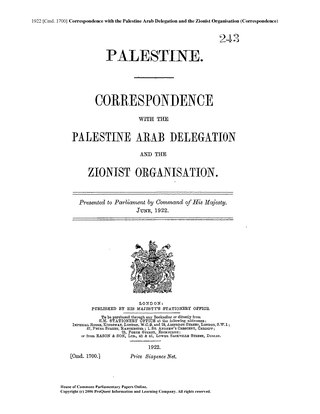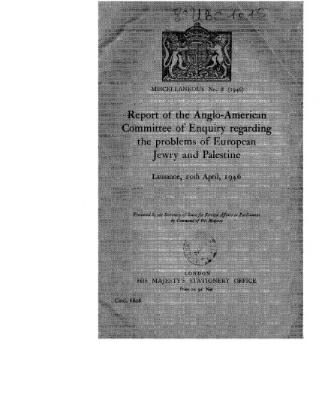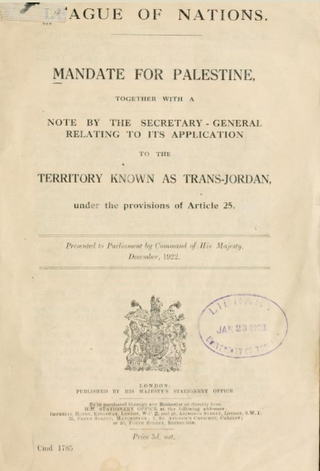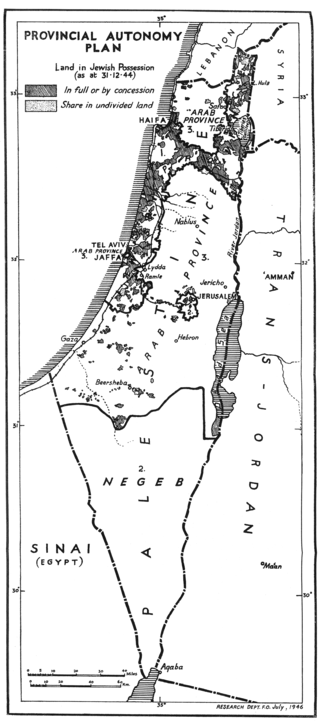
The Balfour Declaration was a public statement issued by the British government in 1917 during the First World War announcing its support for the establishment of a "national home for the Jewish people" in Palestine, then an Ottoman region with a small minority Jewish population. The declaration was contained in a letter dated 2 November 1917 from the United Kingdom's Foreign Secretary Arthur Balfour to Lord Rothschild, a leader of the British Jewish community, for transmission to the Zionist Federation of Great Britain and Ireland. The text of the declaration was published in the press on 9 November 1917.

Zionist political violence refers to politically motivated violence or terror perpetrated by Zionists. The term is used to describe violence committed by those who support the political movement of Zionism, and violence committed against opponents of Zionism. The violence often takes the form of terrorist attacks and has been directed against both Jewish and Arab targets. The most active period of most notable Zionist political violence began on June 30, 1924, through the 1940s, and continues to the present day, usually for the purpose of expanding Zionist settlements in Palestine.

The British administrative headquarters for Mandatory Palestine, housed in the southern wing of the King David Hotel in Jerusalem, were bombed in a terrorist attack on 22 July 1946 by the militant right-wing Zionist underground organization the Irgun during the Jewish insurgency. 91 people of various nationalities were killed, including Arabs, Britons and Jews, and 46 were injured.

Chaim Azriel Weizmann was a Russian-born biochemist, Zionist leader and Israeli statesman who served as president of the Zionist Organization and later as the first president of Israel. He was elected on 16 February 1949, and served until his death in 1952. Weizmann was fundamental in obtaining the Balfour Declaration and later convincing the United States government to recognize the newly formed State of Israel.

The Churchill White Paper of 3 June 1922 was drafted at the request of Winston Churchill, then Secretary of State for the Colonies, partly in response to the 1921 Jaffa Riots. The official name of the document was Palestine: Correspondence with the Palestine Arab Delegation and the Zionist Organisation. The white paper was made up of nine documents and "Churchill's memorandum" was an enclosure to document number 5. While maintaining Britain's commitment to the Balfour Declaration and its promise of a Jewish national home in Mandatory Palestine, the paper emphasized that the establishment of a national home would not impose a Jewish nationality on the Arab inhabitants of Palestine. To reduce tensions between the Arabs and Jews in Palestine the paper called for a limitation of Jewish immigration to the economic capacity of the country to absorb new arrivals. This limitation was considered a great setback to many in the Zionist movement, though it acknowledged that the Jews should be able to increase their numbers through immigration rather than sufferance.

Herbert Louis Samuel, 1st Viscount Samuel, was a British Liberal politician who was the party leader from 1931 to 1935.

Operation Agatha, sometimes called Black Sabbath or Black Saturday because it began on the Jewish sabbath, was a police and military operation conducted by the British authorities in Mandatory Palestine. Soldiers and police searched for arms and made arrests in Jerusalem, Tel Aviv, Haifa and several dozen settlements; the Jewish Agency was raided. The total number of British security forces involved is variously reported as 10,000, 17,000, and 25,000. About 2,700 individuals were arrested, among them future Israeli Prime Minister Moshe Sharett. The officially given purpose of the operation was to end "the state of anarchy" then existing in Palestine. Other objectives included obtaining documentary proof of Jewish Agency approval of sabotage operations by the Palmach and of an alliance between the Haganah and the more violent Lehi and Irgun, destroying the Haganah's military power, boosting army morale and preventing a coup d'état being mounted by the Lehi and Irgun.

The Peel Commission, formally known as the Palestine Royal Commission, was a British Royal Commission of Inquiry, headed by Lord Peel, appointed in 1936 to investigate the causes of unrest in Mandatory Palestine, which was administered by Great Britain, following a six-month-long Arab general strike.

The White Paper of 1939 was a policy paper issued by the British government, led by Neville Chamberlain, in response to the 1936–1939 Arab revolt in Palestine. After its formal approval in the House of Commons on 23 May 1939, it acted as the governing policy for Mandatory Palestine from 1939 to the 1948 British departure. After the war, the Mandate was referred to the United Nations.

The Anglo-American Committee of Inquiry was a joint British and American committee assembled in Washington, D.C., on 4 January 1946. The committee was tasked to examine political, economic and social conditions in Mandatory Palestine and the well-being of the peoples now living there; to consult representatives of Arabs and Jews, and to make other recommendations 'as may be necessary' to for ad interim handling of these problems as well as for their permanent solution. The report, entitled "Report of the Anglo-American Committee of Enquiry Regarding the Problems of European Jewry and Palestine", was published in Lausanne on 20 April 1946.
The Passfield White Paper, issued October 20, 1930, by colonial secretary Lord Passfield, was a formal statement of British policy in Palestine, which previously had been set by the Churchill White Paper of 1922. The new statement resulted from the Hope-Simpson Commission's investigation into the deeper causes of the 1929 Palestine riots, that initially started over access to the Western Wall. The white paper limited official Jewish immigration to a much greater degree.
The Jewish Resistance Movement, also called the United Resistance Movement (URM), was an alliance of the Zionist paramilitary organizations Haganah, Irgun and Lehi in the British Mandate of Palestine. It was established in October 1945 by the Jewish Agency and operated for some ten months, until August 1946. The alliance coordinated acts of sabotage to undermine the British authority in Mandatory Palestine.

The Mandate for Palestine was a League of Nations mandate for British administration of the territories of Palestine and Transjordan, both of which had been conceded by the Ottoman Empire following the end of World War I in 1918. The mandate was assigned to Britain by the San Remo conference in April 1920, after France's concession in the 1918 Clemenceau–Lloyd George Agreement of the previously-agreed "international administration" of Palestine under the Sykes–Picot Agreement. Transjordan was added to the mandate after the Arab Kingdom in Damascus was toppled by the French in the Franco-Syrian War. Civil administration began in Palestine and Transjordan in July 1920 and April 1921, respectively, and the mandate was in force from 29 September 1923 to 15 May 1948 and to 25 May 1946 respectively.

The London Conference (1939), or St James's Palace Conference, which took place between 7 February-17 March 1939, was called by the British Government to plan the future governance of Palestine and an end of the Mandate. It opened on 7 February 1939 in St James's Palace after which the Colonial Secretary, Malcolm MacDonald held a series of separate meetings with an Arab and a Jewish delegation, because the Arab delegation refused to sit in the same room as the Jewish delegation. When MacDonald first announced the proposed conference he made clear that if no agreement was reached the government would impose a solution. The process came to an end after five and a half weeks with the British announcing proposals which were later published as the 1939 White Paper.

Mandatory Palestine was a geopolitical entity established between 1920 and 1948 in the region of Palestine under the terms of the League of Nations Mandate for Palestine.

The Morrison–Grady Plan, also known as the Morrison Plan or the Provincial Autonomy Plan was a joint Anglo-American plan announced on 31 July 1946 for the creation of a unitary federal trusteeship in Mandatory Palestine.
The MacDonald Letter of 13 February 1931, also known as the Black Letter, was a letter from British prime minister Ramsay MacDonald to Chaim Weizmann, prominent Zionist leader, in response to the Passfield White Paper. The White Paper limited Jewish immigration to Palestine and Jewish purchase of Arab land. Zionist organizations worldwide mounted a vigorous campaign against the document, which culminated in MacDonald's "clarification" of the White Paper, reaffirming British support for the continuation of Jewish immigration and land purchase in Palestine. It was considered a withdrawal of the Passfield White Paper, despite the fact that Prime Minister said in parliament on 11 February 1931 that he was "very unwilling to give the letter the same status as the dominating document" i.e. the Passfield White Paper. The letter itself also claimed the importance of justice for "non-Jewish sections of the community".
The British Mandate for Palestine was finally confirmed in 1922. The civil Mandate administration was formalized with the League of Nations' consent in 1923 following the ratification of the Treaty of Lausanne.

The London Conference of 1946–1947, which took place between September 1946 and February 1947, was called by the British Government of Clement Attlee to resolve the future governance of Palestine and negotiate an end of the Mandate. It was scheduled following an Arab request after the April 1946 Anglo-American Committee of Inquiry report.

The end of the British Mandate for Palestine was formally made by way of the Palestine bill of 29 April 1948. A public statement prepared by the Colonial and Foreign offices confirmed termination of British responsibility for the administration of Palestine from midnight on 14 May 1948.
















